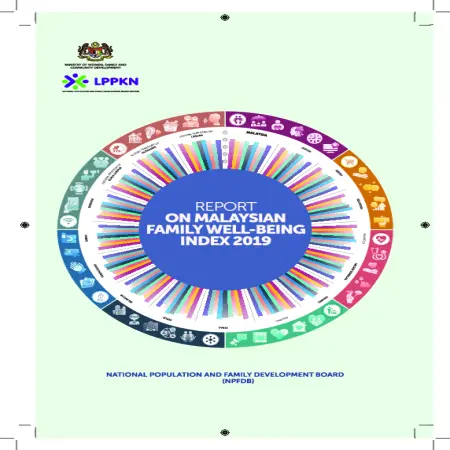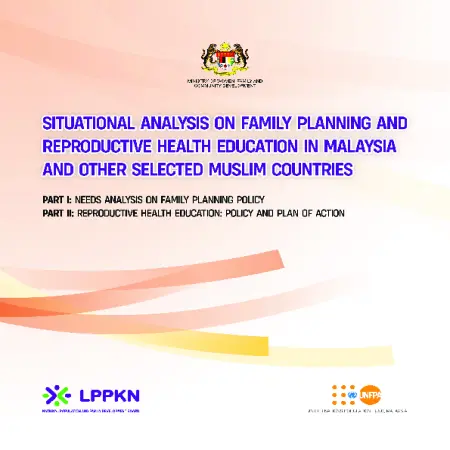Browse by Year
Results for Year : "2020"
|
|
Indeks Kesejahteraan Keluarga Malaysia 2019
Item Type: Infographic
Editor:
Year: 00/00/2020
Abstract: The Malaysian Family Well-Being Index is a multi -dimensional benchmark that specially developed to measure levels family well-being in Malaysia. Index is generated through maternal or paternal assessment to the well -being of their families. The Family Well-being Index 2019 score has increased to 7.72 from a maximum scale of 10 compared to 7.33 in 2016.
|
|
|
|
|
|
Report on Malaysia Family Well-Being Index 2019
Item Type: Research Report
Editor:
Year: 00/00/2020
Abstract: The Family Well -Being Index (FWI) is a multi -dimensional benchmark specially developed to measure the level of family well -being in Malaysia. This index is generated through a mother’s or father’s assessment of their family’s well -being. The 2019 Malaysian Family Well -Being Index score recorded in this study is 7.72 out of a maximum scale of 10. Of the eight domains that have been identified, the Family Relationship Domain recorded the highest domain score of 8.35. This is followed The study also found that the 2019 FWI score is increasing according to household income group. The 2019 FWI score is higher in families living in rural areas. In terms of family type, FWI 2019 scores were higher in family groups by Family Domain, Role of Religion and Spiritual Practice (8.25), Family Domain and Community Involvement (8.00), Family Safety Domain (7.86), Family Economics Domain (7.67), Family Health Domain (7.44), Housing and Environment Domain (7.35) and Family and Communication Technology Domain (6.82). Although the score of FWI 2019 is still at a moderate level but it has shown an increase of 0.39 points compared to 7.33 for FWI 2016.
|
|
|
|
|
|
Situational analysis on family planning and reproductive health education in Malaysia and other selected Muslim countries Part I: needs analysis on family planning policy Part II: reproductive health education: policy and plan of action
Item Type: Research Report
Editor:
Year: 00/00/2020
Abstract: This study is an initiative by the Ministry of Women, Family and Community Development (MWFCD) through the National Population and Family Development Board (NPFDB) in collaboration with the United Nations Population Fund (UNFPA), who has been a strategic partner of NPFDB since the 1990s in the Sexual and Reproductive Health (SRH) programmes. This study was conducted at where there are rapid changes in the population dynamics and demographic trends together with the advancement in human capacity development and new communication technologies.
It is an effort that enables the nation to achieve its commitment locally towards Malaysia’s Shared Prosperity Vision 2030 agenda and internationally, such as the ICPD Plan of Action. The objective of the study is to identify the best practices of reproductive and sexual health (SRH) programs including family planning and reproductive and sexual health education (SRHE) among selected Islamic countries that practice sunni sects to provide direction to Malaysia. Five (5) countries were selected for the purpose of comparison with Malaysia are Turkey, Egypt, Morocco and Bangladesh.
The report of this study proposes several strategies and improvements as a result of a gap analysis with other Muslim countries that can help strengthen the strategy and implementation of the National Sexual and Reproductive Health programmes to improve reproductive health indicators such as Maternal Mortality Rate, Infant Mortality Rate and Age Specific Fertility Rate, as well as reducing the number of cases of teenage pregnancy, abortion, sexual abuse and sexual crimes.
|
|
|
|
|
|
Seroprevalence and factors associated with chlamydia trachomatis Infection among subfertile couples attending local public subfertility clinic
Item Type: Thesis
Editor:
Year: 00/00/2020
Abstract: Chlamydia trachomatis is one of the agents that cause the sexually transmitted infections called chlamydia. People practicing risky sexual behaviours such as having multiple sex partners, exercising sexual intercourse at an early age, and undergoing unprotected sexual
intercourse (without condom) with casual partners, are at risk of getting Chlamydia trachomatis infection. One of the significant, long term implications of risky sexual behaviours and sexually transmitted infection is infertility problems. The objectives of this study are to determine the seroprevalence of Chlamydia trachomatis (CT) among subfertile couples (husband and wife) of The Lembaga Penduduk dan
Pembangunan Keluarga Negara (LPPKN) Subfertility Clinic and the factors associated with it (i.e. socio-demographic, duration of marriage, infertility factor, knowledge, attitude, practice of risky sexual behaviour (RSB) and predictors of Chlamydia trachomatis infection). The study is a cross-sectional study involving 112 infertile couples who underwent fertility treatment at LPPKN Subfertility Clinic from February 2018 until February 2019. Sociodemographic factors, duration of marriage, infertility factor, knowledge, attitude and practice (KAP) of risky sexual behavior (RSB) variables were determined via self-administered
questionnaire that includes close ended questions. Meanwhile, Chlamydia trachomatis antigen and antibody (CT IgG) were determined via Enzyme Linked Immunosorbent Assay (ELISA) and rapid visual immunoassay test kit. This approach is selected to detect past and
current infections of Chlamydia trachomatis through antibody and antigen detection in the blood serum, endocervical swab and urine samples. The response rate of this study was 97.39%. Majority of the respondents were aged between 25-34 years old and dominated by Malay ethnicity. Half of the respondents were among those with tertiary level of education and working in the private sector. In term of duration of marriage, half of the samples were couples who have been married for 3-7 years with majority of them had primary infertility. The female factor was reported to be the most dominant, followed by the unexplained factor and male factor. The seroprevalence of Chlamydia trachomatis among subfertile couples was 22.1% with 14.7% in husbands and 17.9 %, was reported among wives. In terms of knowledge, the results showed that most couples had high level of knowledge
about risky sexual behaviours with a score of more than the mean (> 6) for both husbands and wives. Meanwhile, each husband and wife group had positive attitude towards risky sexual behavior. Approximately, 35.7% of husbands and 12.5% of wives were engaged with risky sexual behavior while a higher percentage of premarital sex was reported among the husbands compared to the wives. The chi-square results showed no association between CT status and socio -demographic factors, marital status and knowledge of RSB among subfertile couples. A significant association was recorded between CT and practices of RSB among couples (p< 0.05) particularly among those with multiple sex partners and husbands who had premarital sex (p<0.05). However, the Binary Logistic Regression analysis showed that none of the selected variables were significant predictors of CT status among the couples (p> 0.05). This study has determined that the seroprevalence of Chlamydia trachomatis (22.1%) and practices of risky sexual behavior among subfertile couples were high. Even though the results have shown no association between the dependent and independent variables, our finding has given an evidence based detection of past infection of Chlamydia trachomatis among
subfertile couples. The practice of RSB has interrelated risk of getting CT and its long term consequences particularly on women reproductive system. Since the awareness on CT among public is considered low, it is crucial to sensitize them about it to ensure early detection and prevention. Therefore, CT screening is strongly recommended to be integrated in fertility work up. treatment and be promoted among sexually active adolescents and those young in age.
|
|
|
|








